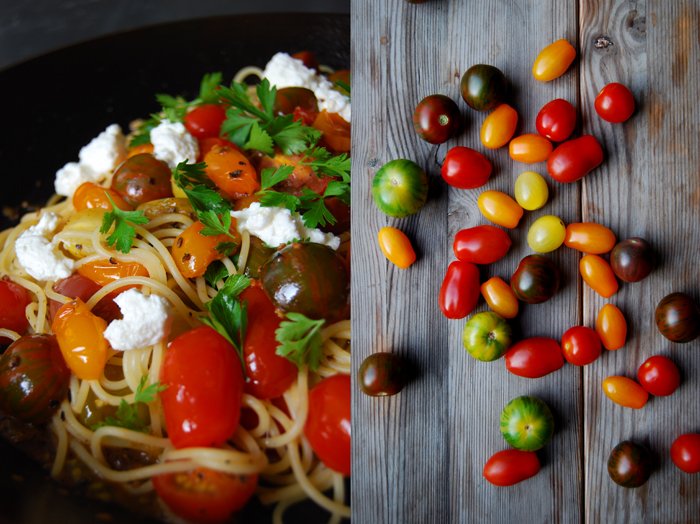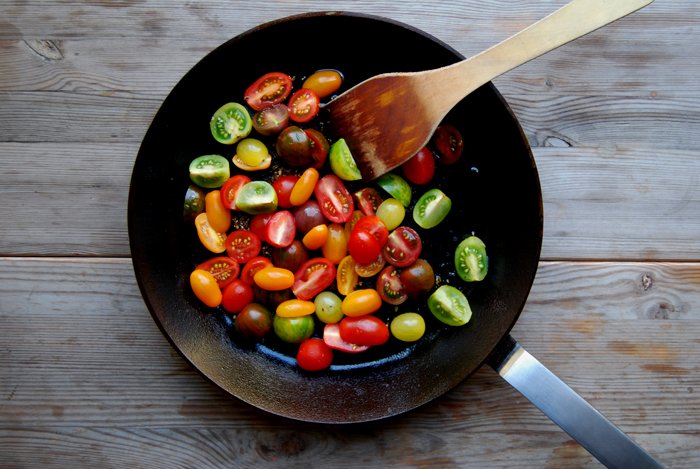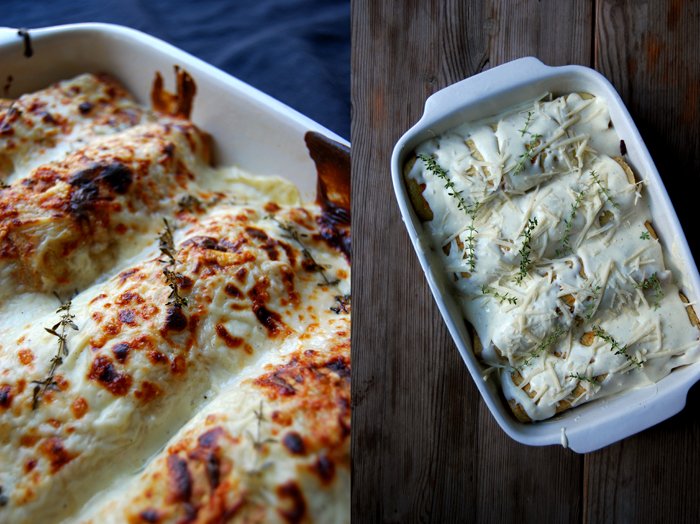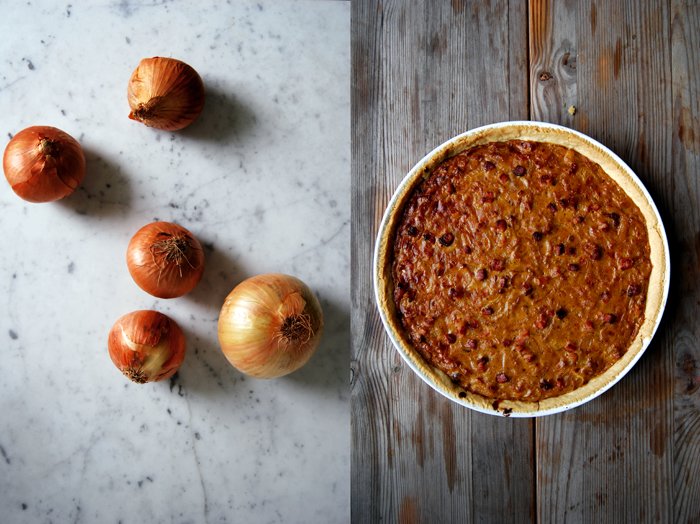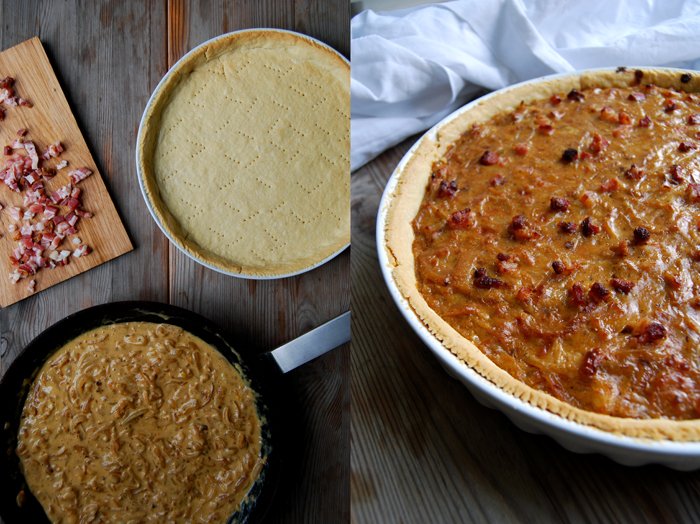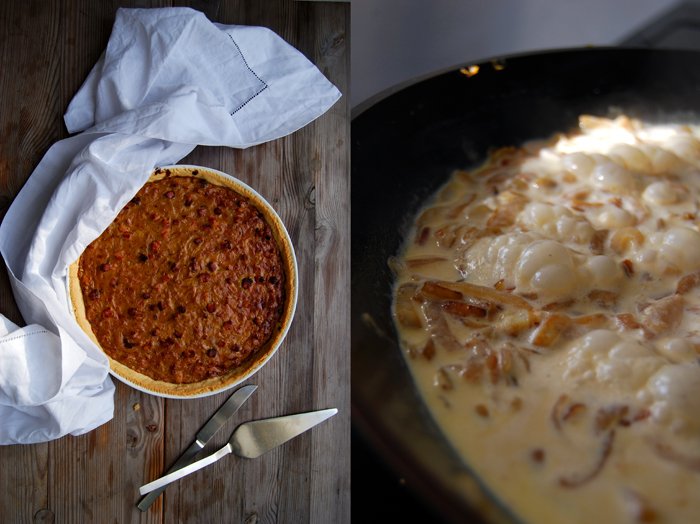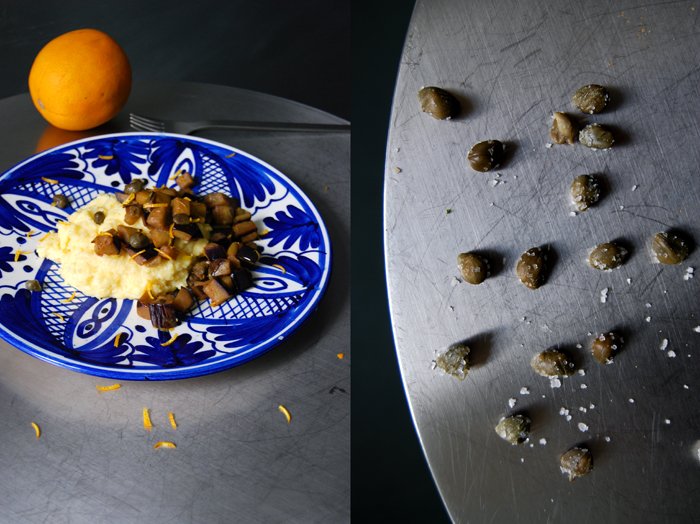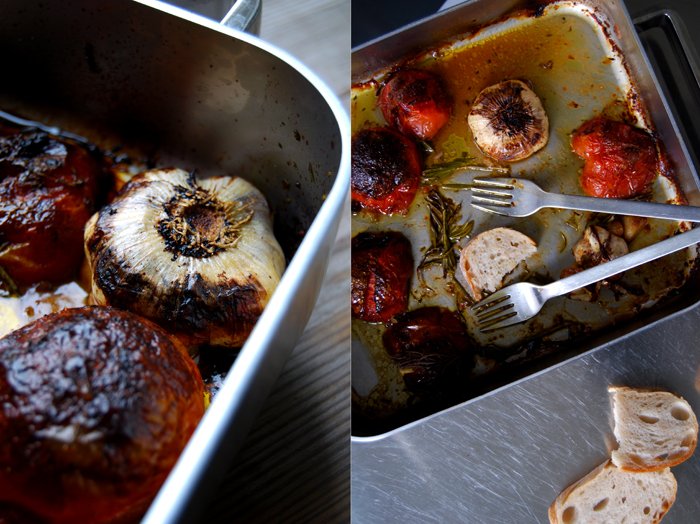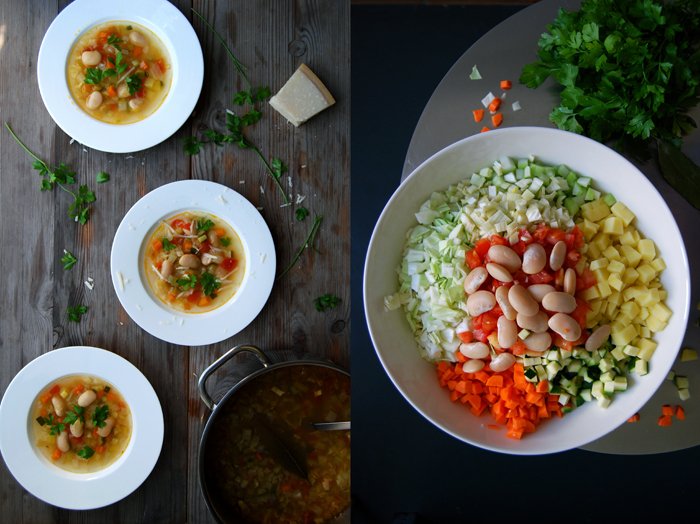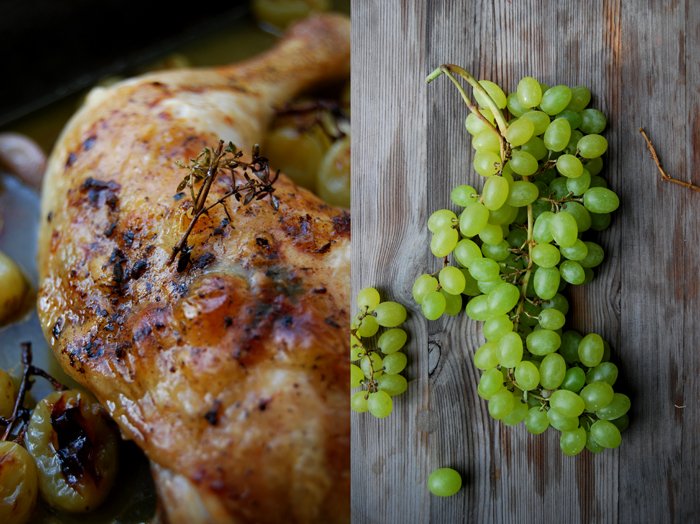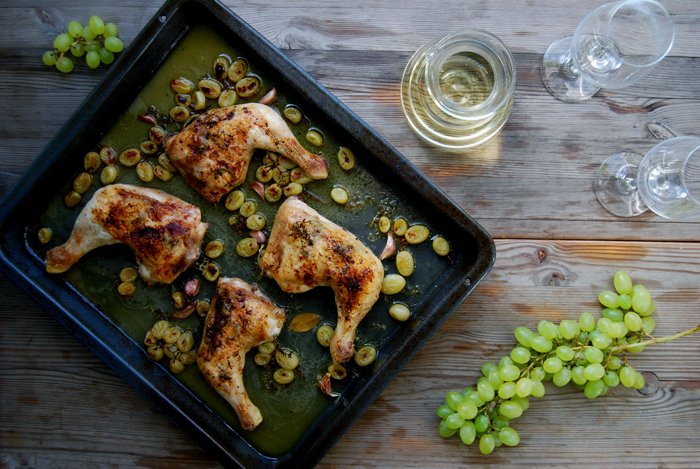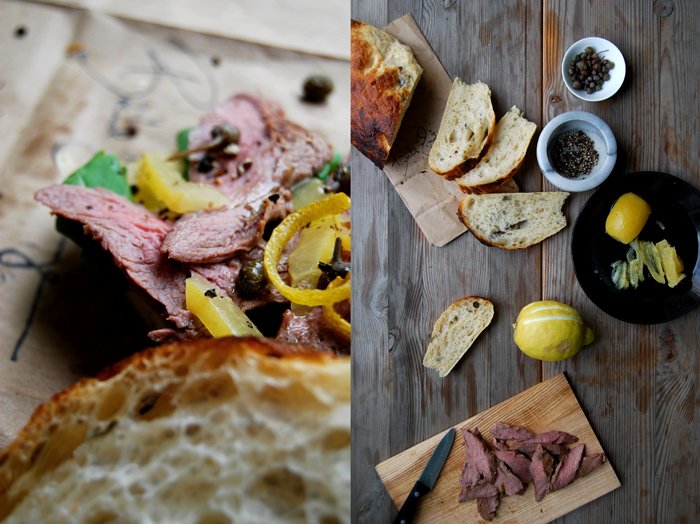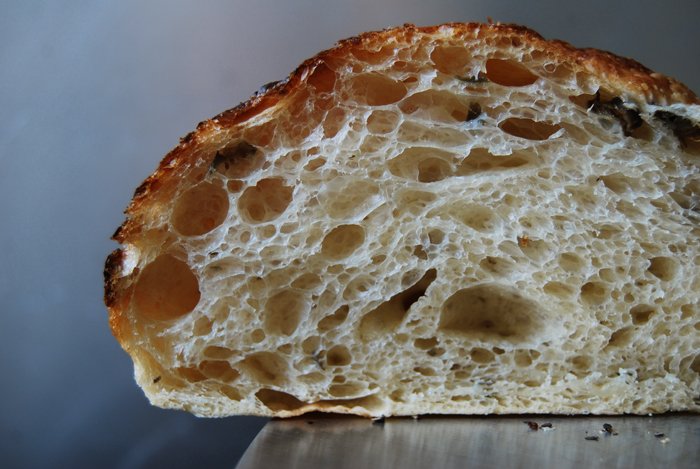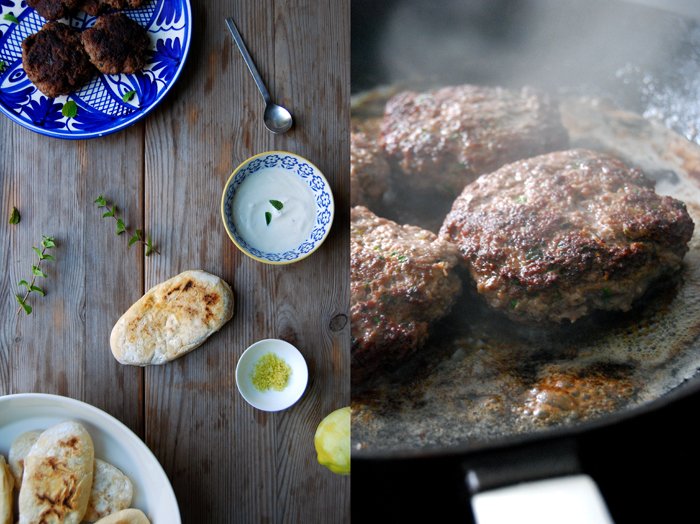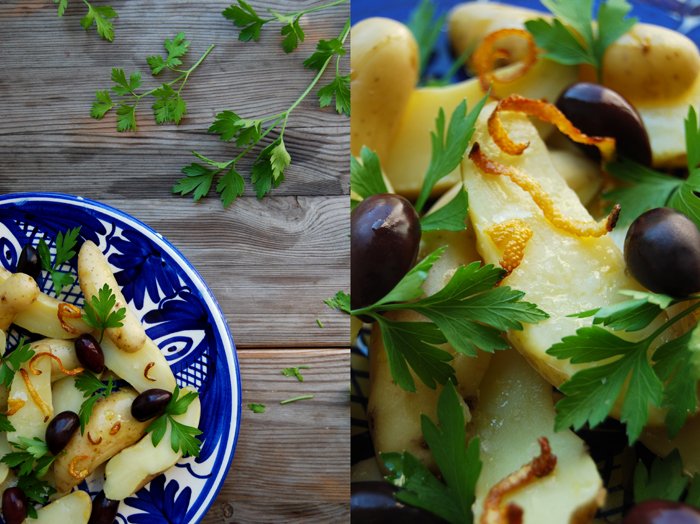Fish & Chips
Berlin, October 2014:
Beer is back in the kitchen! Since I used it for my Bavarian Beer Roasted Pork last week I don't want to let go of it. This time it's mixed into a batter that makes the most amazing fried fish: a thin crisp layer that keeps the fish juicy on the inside!
I had the best fish and chips in my life when I lived in the north of England. In my temporary hometown of Whitby, you can find England's best fish and chip restaurant repeatedly awarded The National Fish & Chip Award. If you ever visit this beautiful town in North Yorkshire, I can only recommend stopping at Quayside at the pier to enjoy this treat. It's fantastic! Although I know that I can't compete with them, a family of third generation chippies, I still wanted to (try to) reach the high standards that I got used to while I lived there. I bought good quality fish, beer and potatoes, the three crucial ingredients for this meal, and started my first batch of fish & chips!
The result was delicious and surprisingly easy to achieve. I used a tall, large pot (the same one I use for my jams) and lots of sunflower oil. Cod or haddock with firm meat works best, the filets shouldn't be too thin (about 1 1/2 cm / 1/2") to avoid them turning soft and mushy. For the chips, you should always use the best waxy potatoes you can find and cut them into thin strips. I wanted mine golden, slim and crisp and you will only succeed if they are cut the right size. Another secret I've learnt is to fry them twice and put them on kitchen roll for a few seconds before you sprinkle them with salt, or like I did, with some added crushed pepper.
In Germany, we like to put fried fish in a bun, but today, I enjoyed it in traditional British fashion, with only chips on the side. I left the mushy peas out, a tradition that I never really got into.
Fish & Chips
For the chips, it works best if you use a large pot with a frying basket. If you fry them without a basket you will have to take them out with a slotted ladle which takes a bit longer.The oil is very hot, so you should always keep that in mind and fry with lots of care. Although this is a child friendly meal, the preparation isn't! I fried the potatoes first then followed by the fish but you could also do it the other way around.
For 2 hungry people you need
sunflower oil for deep-frying, around 1.2l / 2.5 pints (plus more depending on the size of the pot you use)
For the chips
waxy potatoes (uncooked), peeled and cut into strips (around 7mm / 1/4" thick), 1.2kg / 2.5 pounds
salt and crushed black pepper
Rinse the potatoes and dry them well between kitchen paper, fry them in 2-3 batches.
Heat 1l / 2 pints of the oil in a large pot. Check if it's hot enough with a wooden toothpick, little bubbles should form around the toothpick.
First, fry the potatoes for 4 minutes until light golden, shaking the basket gently after 2 minutes (or use a slotted ladle to move them around). After 4 minutes, take them out, let the oil drip off and spread them on kitchen paper to remove excess oil.
Fry them a second time for 3 minutes or until they are golden brown, mind that they don't get too dark. Take the chips out, spread them on kitchen paper and put them in a large bowl. Sprinkle them with salt and pepper and continue with the next batch.
For the fish
fresh firm fish fillet (like cod, haddock or pollack), pin-boned, rinsed and dried, 400g / 14 ounces
beer 50ml / 2 ounces
plain flour 50g / 2 ounces
organic egg white 1
a pinch of salt
Add the remaining oil to the pot and heat it up.
Mix the beer and flour until combined. Beat the egg white with a pinch of salt until stiff and gently fold half of it into the beer flour mixture. You can use the rest of the egg white for something else.
Pull the fish through the batter until it's coated all around. Check that the oil is hot enough and fry the fish (without the basket) for 4 minutes or until golden and crisp. Take it out and put on kitchen paper to remove excess oil. Season with salt and serve with the chips.
Spicy Cumin Fennel Spaghetti with Tomatoes, Ricotta and Lemon
A few days after we got home from our summer holidays, the two of us met in the kitchen late in the evening, not sure what to make for dinner. Usually, a night like this calls for pasta and a simple tomato sauce, but we were in the mood for more, we wanted some spices on our plates! A quick look in the fridge offered a bunch of cherry tomatoes, fresh ricotta and a jar full of my Moroccan preserved lemons. The parsley on the kitchen counter looked like it wouldn't last much longer but the leaves were still crisp and green. We pulled out the mortar and the pan, heated up some olive oil and crushed a spoonful of black peppercorns and our Maltese fennel seeds. We cooked the spices with a pinch of cumin in the oil for just a minute to unfold their aromas. When their peppery smell filled the whole kitchen, we added the chopped lemons and cherry tomatoes. After 3 minutes it was all done, ready to be mixed with the spaghetti, some lumps of ricotta and the fresh parsley leaves.
It was great, spicy and fragrant, a delicious mixture of the Italian and Arabic cuisine. Unfortunately, we had forgotten about this dinner. It was quite late, we were tired and we went to bed straight after we savored this meal. Weeks later, I remembered our spontaneous cooking session but it took me a while to recapture the recipe. So here it is, we cooked it again and loved it just as much!
Spicy Cumin Fennel Spaghetti with Tomatoes, Ricotta and Lemon
For 2 people you need
spaghetti 200g / 7 ounces
cherry tomatoes, cut in half or quartered, 400g / 14 ounces
ricotta 125g / 4.5 ounces
Moroccan preserved lemon, chopped, 1/4 or the zest of 1/2 lemon
black peppercorns, lightly crushed in a mortar, 1 - 1 1/2 teaspoons (depending on the spiciness you want to achieve)
fennel seeds, lightly crushed in a mortar, 1 teaspoon
cumin, a generous pinch
salt
olive oil
parsley, the leaves of 1/2 small bunch
Cook the pasta al dente in lots of salted water.
In a large, heavy pan, heat a splash of olive oil and cook the spices on medium-high heat for 1-2 minutes. Add the lemon (preserved or zest) and cook for a few seconds before you stir in the tomatoes. Cook the tomatoes for 1-2 minutes until they start to soften and take the pan off the heat. Season with salt, mix in the spaghetti and top with ricotta and parsley.
Beluga Lentil Salad with Pear, Blue Cheese and Thyme
When I went through the shelves of my pantry to bring some order to the boxes and bags filled with all kinds of dried lentils, beans and seeds, an open bag of Beluga lentils fell into my hands. I could have chosen Swabian Heirloom lentils, or the red, yellow or green legumes, but this time my eyes got stuck on these pearly black beauties.
The black seeds inspired me to make a salad that looks like it came right out of a Renaissance painting, dark, dramatic and a bit mystic (although it's just food, it has its own aura). Beluga lentils don't need much preparation, no soaking in water and they're done in just 20 minutes. I cooked them with a bay leaf and a handful of lemon thyme sprigs and stirred in a little bit of olive oil after they soaked up all the cooking liquid. For my salad, I cut a firm pear very thinly with a cheese slicer and arranged the sweet slices on top of the warm lentils with small lumps of Fourme d'Ambert. You could also use a ripe Stilton or a soft Gorgonzola if you prefer a more subtle blue cheese flavour.
I like it when the white cheese melts into the warm dark lentils but you can also serve it as a cold salad.
Beluga Lentil Salad with Pear, Blue Cheese and Thyme
For 4 people you need
Beluga lentils, rinsed, 220g / 8 ounces
bay leaf 1
fresh sprigs of thyme, a small handful (if the sprigs are woody just use the leaves)
olive oil
blue cheese, broken into lumps, 120g / 4.5 ounces
ripe but firm pear, cut in half, cored and sliced with a cheese or vegetable slicer, 1
salt and pepper
Cook the lentils according to the instructions on the package with the bay leaf and thyme but without salt. Mine needed 20 minutes in 750ml / 1.5 pints of water. If the lentils don't soak up all the liquid, drain them but keep the cooking liquid and the sprigs of thyme. Stir a splash of olive oil into the lentils and season with salt and pepper to taste. Now, you can add a little of the cooking liquid if the salad is too dry.
Put the lentils into a large bowl with some of the thyme sprigs and arrange the pear and cheese on top. Serve warm or cold.
Bavarian Beer Roasted Pork with Sweet Potatoes and Parsnip
Update: You can also find this recipe in my 1st book, Eat In My Kitchen - To cook, to bake, to eat, and to treat.
This is the ultimate roast - Bavarian beer roasted pork, also known as Bayerischer Schweinebraten or Krustenbraten. When I visited the Deyerling siblings last week for a meet in your kitchen feature, they reminded me of this traditional roast. You can't really ask for more, tender, juicy meat and crunchy crackling on top, perfectly roasted and crispy. This is hearty, honest autumn food, for those cold nights after a long walk out in the countryside. That's exactly what we did!
A few days ago we decided to leave the city for a few hours to visit one of Berlin's beautiful lakes that you can reach after a short train ride. The Müggelsee lake is my beloved escape whenever I need a break from the buzz. It's a huge lake, peaceful and quiet surrounded by thick forest. Autumn is just starting to show, so the leaves were still quite green but I could smell the change of the seasons. We have a little tradition, we always stroll down the town's high street before we go to the lake. We visit the local bakery and butcher, for some cake and bread, sausages and to look for some inspiration. Both of them are traditional businesses, and I have to say that I look forward to checking their daily offer just as much as to walking at the lake. This time we made our choice as soon as we got into the butcher's shop. A nice big piece of pork caught our attention and reminded us of the wonderful Bavarian beer roasted pork we cook in winter. The butcher put it aside for us along with a few other delicacies while we continued our walk. On our way back to the train station we picked up our bags and couldn't wait to get started with our oven roast!
There are various ways to roast pork to achieve the perfect crackling. My mother cooks it skin side down first in a little bit of broth before she turns it around. As much as we love to share recipes, here we disagree. I cook mine skin side up without turning the meat. I rub lots of salt and crushed cloves into the scored rind and cook the meat in its own juices for 1 1/2 hours. At this point I add the beer and vegetables, cinnamon, star anise and mustard seeds. I chose sweet potato, onion and parsnip to roast in the strong juices until it's all golden and crisp on the outside and soft inside. I like to season the gravy with some Dijon mustard and fruity jelly, like elderflower or peach, but you could could also use honey or maple syrup.
I can't really say how I prefer this dish, fresh and warm out of the oven with a pint of beer and some potato dumplings on the side or the next day, sliced thinly with some chutney in a sandwich!
Bavarian Beer Roasted Pork with Sweet Potatoes and Parsnip
Update: you can also find this recipe in my 1st book Eat In My Kitchen - To cook, to bake, to eat, and to treat.
For this recipe, you need a well sized piece of pork shoulder, smaller pieces tend to dry out, it can be boned or on the bone. I have made this recipe with both. The rind has to be scored in a pattern (as you can see in the pictures). You can ask your butcher to do this or cut the pattern yourself with a sharp knife, just mind that you don't cut into the meat!
If you want to make potato dumplings on the side, the famous Knödel, you can use my Gnocchi dough. You just have to shape walnut sized balls out of the dough and fill each of them with 3 small cubes of white bread. Cook them in lots of salted water for about 10 minutes on medium-low temperature until the dumplings swim on the surface.
For 4-6 people you need
pork, shoulder piece, boned, scored, 1500g / 3.5 pounds (if you use a piece of pork with the bone leave it in the oven for 1 - 1 1/2h after you poured over the beer)
cloves, ground in a mortar, 10
salt
beer 500ml / 1 pint
medium onions, quartered, 3
sweet potatoes, scrubbed, cut into cubes, 2
parsnips, scrubbed, cut into cubes, 3
cinnamon stick, broken into 3 pieces, 1
star anise 3 single pieces
mustard seeds 2 heaping tablespoons
For the gravy
broth 175ml / 0.5 pints
elderflower (or any other fruity) jelly 1 tablespoon plus more to taste
Dijon mustard 1/2 teaspoon plus more to taste
pepper
Set the oven to 175°C / 350°F (I use the Rotitherm setting).
Mix the cloves with 2 heaped teaspoons of salt and rub into the scored rind, depending on the meat's surface you might need more salt. Put the meat on a deep tray skin side up and cook for 1 1/2 hours.
Take the tray out, pour the beer over the meat and arrange the spices and vegetables on the sides (don't add the jelly and Dijon mustard yet). Cook for another 30-45 minutes until the crackling is crisp. Take out the vegetables and meat and mix the gravy on the tray with the broth, jelly and mustard and season with salt and pepper to taste. Take out the cinnamon stick and star anise and pour into a gravy boat (you can cook it down in a sauce pan for a few minutes if you prefer a more concentrated taste). Serve with the meat and vegetables.
If the rind isn't crisp enough yet, turn on the grill (broiler) for a few minutes after you've removed the vegetables, gravy and spices and cook the meat until the crackling is light and crispy!
Crespelle with Radicchio, Potato and Thyme
It took me a while to use radicchio not only raw for salads but cooked as well. It was a late discovery, but once I tried it, I loved it, especially for the Italian cuisine! One of my favourites is linguine with radicchio, mustard butter and sautéed chicken liver. My friend Judith told me about this recipe and it became a winter pasta classic in my kitchen. Or my purple risotto with spices and thyme, the colour is beautiful and the mixture of cloves, bay leaf and red wine is so aromatic and rich. Radicchio is great, it's so strong, its unique bitterness is so dominant that it asks for more flavours to be added to it.
A couple days ago I mentioned that we had family from LA staying with us, so our days were split between walking through the city for some sightseeing and food, either from my kitchen or from one of the great places we visited. Italian restaurants, German restaurants, department stores (we focussed on the fish section), various cafés specialized in German cake, American cake or chocolates from all over the world. We savored for days, as always!
Coming back to the purple radicchio and to one of our lunches at home, I cooked crespelle for us one day, filled with a bitter sweet stuffing of radicchio, potatoes and thyme. I used the herb to refine the pancake dough and the filling which made it come though quite strong. It added a bit more taste to the crepes which would have been to soft for this filling on their own. All the bitterness and sweetness wrapped in these thin pancakes with a creamy Béchamel sauce inside and on top made us all enjoy in silence for a short while, until our delicious Italian wraps were gone!
Here's a springy green version of my crespelle that I wrote about in March, filled with spinach.
Radicchio, Potato and Thyme Crespelle
For 4 filled crespelle you need
radicchio, quartered and sliced, 300g / 10.5 ounces
potatoes, cooked, sliced and quartered, 400g / 14 ounces
fresh thyme leaves 2 tablespoons
garlic, finely chopped, 2
red wine 60ml / 2 ounces
balsamic vinegar 1 teaspoon
Parmesan, grated, 2 tablespoons
olive oil
salt and pepper
In a large pan, heat a splash of olive oil, add the garlic and radicchio and sauté for about 4 minutes or until soft on medium heat. Deglaze with the red wine, take off the heat and stir in 2 tablespoons of thyme and the vinegar. Season with salt, pepper and vinegar to taste.
For the Béchamel sauce
milk 600ml
butter 30g / 1 ounce
plain flour 30g / 1 ounce
bay leaf 1
a pinch of nutmeg, grated
salt and pepper
In a saucepan, bring the milk with the bay leaf, nutmeg, salt and pepper to the boil.
Melt the butter and whisk in the flour, let it cook on medium heat for 1 minute. Take off the heat and slowly add the hot milk, whisk until smooth and cook for about 3-5 minutes on lowest heat until it's thick and creamy. Discard the bay leaf and season to taste.
For the crespelle
milk 160ml
organic eggs 2
plain flour 130g / 4.5 ounces
salt 1/4 teaspoon
fresh thyme leaves 1 tablespoon
butter for frying
Mix the ingredients well and let the dough rest for 5 minutes. Heat some butter in a large pan and fry 4 thin crespelle, one at a time, golden on both sides.
To assemble
Set the oven to 200°C / 400F (top/ bottom heat).
Lay a crespelle flat on a plate, spread with 1/4 of the radicchio and potatoes and sprinkle 2 tablespoons of the Béchamel sauce on top, roll into a wrap. Continue until all four are done and put them next to each other in a baking dish. Pour the remaining sauce on top and sprinkle with parmesan. Bake for 12 minutes or until golden brown. Switch on the grill for the last 1-2 minutes, this makes the crespelle a little bit crisp.
Zucchini Risotto with crisp Sage
There's something about fresh sage cooked in a little olive oil to the point of perfection! When the thick leaves become all glossy and golden, crisp and so full of flavour that they turn a simple dish into a fragrant composition with such ease - that's exactly what this bunch of herbal crunchiness did with my simple risotto!
Our dinner started innocent and pure, I just cooked my Arborio rice with some chopped onions in white wine and broth before I mixed in juicy slices of golden sautéed zucchini. The vegetable added a fruitiness which made the whole composition light and fresh, but the crisp sage leaves on top put it on another level. The rich oil they cooked in was an aromatic concentrate of the herbs best qualities, warm and strong! When I arranged the risotto on the plates, I poured this herbal essence over the rice to coat them with this golden syrup.
That's the secret to a great risotto (and not only for risotto), combining just a handful of ingredients that allow their individual qualities to spark!
Zucchini Risotto with crisp Sage
For 4 people you need
zucchini, cut in half and sliced, 350g / 12.5 ounces
sage leaves 30
Arborio rice 400g / 14 ounces
medium onion, finely chopped, 2
vegetable broth around 1800ml / 4 pints (depending on the kind of rice you will need more or less liquid)
white wine 120ml / 4 ounces
salt and black pepper
olive oil
butter 1 tablespoon
Sauté the zucchini in a little olive oil in a pan until golden on both sides and soft. Season with salt and pepper to taste and set aside.
In a small sauce pan, heat 6 tablespoons of olive oil and add the sage leaves. Let them fry until golden and crisp, for about 1 minute but mind that they don't turn dark, set the pan aside.
In a large pot, heat a splash of olive oil and the butter, add the onions and cook on medium heat for about 2-3 minutes until soft. Stir in the rice and cook on medium heat for about a minute. Add the wine and some of the broth, the rice should be covered, stir and turn the heat down to medium-low. When the liquid has been absorbed add more broth, a little at a time stirring in between. Depending on the rice, it will need more or less liquid. When the rice is al dente and the broth is more or less absorbed take it off the heat and season with salt and pepper to taste. Close with a lid and let the risotto sit for a minute.
Divide the risotto and zucchini between the plates, sprinkle with some of the sage oil and top with crisp sage leaves, serve immediately.
meet in your kitchen | The Deyerling's Venison Burger with Bavarian Potato Salad
When I met Anna and Clemens Deyerling for the first time, I noticed the blind understanding and wordless communication between them that only close siblings can have. They know and respect each others roles, in their private life but also in business as they decided to start a company together with their partner Julius, an old friend of Clemens'. In 2010, Sitzfeldt was born, the beginning of an exciting journey and the start of a young online business for affordable design furniture. The Deyerlings come from a family background of furniture and design and they wanted to continue this family tradition, but in their own way. They sat together with designers who already were or became friends over the years and developed various sofa collections. One of them, the Set sofa system, already won the Interior Innovation Award and the renowned Red Dot Design Award.
A few months ago, the young entrepreneurs presented a selection of their collections in one of Berlin's old manorial flats. One spacious room followed the other, separated with large double wing doors, high ceilings decorated with opulent stucco and beautiful timbering on the walls. The siblings chose an amazing location for the presentation but they also managed to create a beautiful evening with great people and food. One of the (not insignificant) reasons why I still remember that day so clearly are Clemens' skills in the kitchen, this man can cook! He treated us to a buffet of various soups and dips, fresh bread and wine and everybody loved it! On that day, Anna was the perfect host, she's not only responsible for the creative presentation of the design which led to a very comfortable atmosphere, but her soft and warm way makes you feel welcome right away. So while her brother was busy in the kitchen on his own (if you read the interview, you'll know why) we got lost in chatting. When I met the two siblings in Anna's gorgeous flat this week for our meet in your kitchen feature, the roles were more or less the same, us chatting while Clemens was cooking.
Clemens made a fantastic venison burger - called Fleischpflanzerl where he comes from - with the most amazing meat from a butcher in the Brandenburg area outside Berlin, accompanied by a light warm Bavarian potato salad inspired by the region where they grew up, the south of Germany.
Venison Burger with warm Bavarian Potato Salad
For 4 people you need
For the burgers
minced venison 500g / 1 pound
white bread, rind cut off, 3 slices
milk 80ml / 3 ounces
medium onion, finely chopped, 1
eggs 2
orange zest 1/2 teaspoon
lemon zest 1/2 teaspoon
mustard 2 teaspoons
fresh parsley, chopped, a small bunch
dried or fresh marjoram, chopped, 1 teaspoon
freshly grated nutmeg
salt 1 - 1 1/2 teaspoons
pepper
olive oil
Soak the bread in the milk for a few minutes. Tear the bread into pieces and mix with your fingers.
Cook the onion in a little olive oil until soft. Whisk the eggs, mustard, orange and lemon zest and season with salt, pepper and nutmeg.
Mix the minced meat with the bread/ milk mixture, the onions, the egg mixture, marjoram and parsley and form the burgers.
In a large, heavy pan, heat a splash of oil and cook the burgers on medium heat until golden brown on both sides and cooked through.
For the potato salad
warm, waxy potatoes, cooked, peeled and sliced, 1kg / 2 1/4 pounds
medium onion, chopped, 1
garden radish, thinly sliced, 4
cucumber, peeled, cut in half and sliced, 1/2
chives, snipped, 1-2 tablespoons
olive oil
For the salad dressing
broth, hot, 400ml / 13.5 ounces
red wine vinegar 3-5 tablespoons
mustard 1 tablespoon
salt and sugar
Cook the onions in a little olive oil until soft.
Mix the hot broth with the vinegar and mustard and season with salt and sugar to taste.
Slowly mix the potatoes with the dressing (not all at once). Stir in the onions, cucumber, radish and chives.
Serve warm with the venison burgers.
Anna and Clemens, you grew up in the south of Germany, in Bavaria. Both of you studied in Germany and in London, when and why did you decide to move to Berlin?
Clemens: I fell in love with Berlin during my studies and tried to find my first job here. I was lucky. In the meantime our entire family - our sister and our parents - also moved to Berlin.
Anna: We grew up in quite a small town in Bavaria. I always dreamt of living in a big city. Berlin has always been on my list and after having spent a few months during my master's program here, I always wanted to come back. I just love the openness and the variety of Berlin. I finally moved here 10 years ago and since then Berlin became home more and more.
Do you miss the kitchen of the south?
Clemens: Oh, yes. I miss it badly. Especially the Schweinebraten (pork roast) our grandmother used to make every single Sunday. I still need it at least once a month, but do it myself now. And what else? Pretzels, Pretzels, Pretzels… I will never understand why no one outside of Bavaria can bake Pretzels as they should be.
Anna: I used to miss it, but fortunately the southern kitchen became quite popular in Berlin over the last few years. So there are good places all over Berlin. When it gets really bad again, I go to Meierei in Kollwitzstraße or I hope for a lunch invitation for Sunday by my brother.
What was the first dish you cooked on your own, what is your first cooking memory?
Clemens: I am not quite sure. I guess, I used to cook with our Mum when we were children. But the first real remembrances to consciously cook was my grandma making the Schweinebraten every Sunday.
Anna: I guess, it was only Clemens who cooked with our Mum... At least, I did not. Because I remember always calling my Mum to ask for help once I lived on my own. And this was for the very basic things, like cooking pasta…
What are your favourite places to buy and enjoy food in Berlin?
Anna: Soluna in Gneisenaustraße, Market at Südstern, Markthalle 9, Meierei, Nansen, Restaurant Obermaier, Massaniello, Txokoa Gastro Bar, Hoastaria del Monte Croce.
Clemens: Markthalle 9, Fräulein Dickes in Stargarder Straße
You started Sitzfeldt, an online company specialised in affordable designer sofas in 2010 together with Julius, an old school friend of Clemens'. What moved you to work in the field of designer furniture?
Due to our father’s business, we have always had a great affinity to furniture and design. At the end, it was this affinity combined with the business potential of selling furniture directly to the end customer via the internet. And of course the wish of building up our own company.
Your father established a successful furniture business and you continue this family tradition with your own company. How does this affect your work? Do you feel responsibility, is the family tradition a gift or a burden?
Anna: Once, someone called Sitzfeldt the 'Unternehmensnachfolge 2.0' (Business successors 2.0). That is pretty much how I feel. Without my father and his experience, we would not have been able to build up Sitzfeldt so quickly. But it makes me proud, that we have always done it our way. And: It makes me happy to see my father proud. Of course, he is happy that something he built up is continued somehow. So, it is a gift – for sure.
Clemens: It is easier to be an entrepreneur, if there are other entrepreneurs in the family. I feel supported and challenged by my family at the same time. And it helps that worries and doubts are understood and shared. The family tradition is a gift – no burden – because it really helps to build upon failures and successes.
Two of your collections have been nominated for the German Design Award 2015. Who are the designers you're working with at the moment and how do these collaborations start?
Anna: The designer we work with the most, is Steffen Kehrle. He actually is an old friend of Julius' who we all met in Milan in 2010. That was the year when the volcano in Iceland was active, so our flights were all cancelled. Steffen had a car and three free seats, so we drove together from Milan to Munich. During that ride we talked a lot about our plans, visions and ideas. When we arrived, it was clear that we would have to work together. That is when we first started to develop our sofa system Set which won the Interior Innovation Award 2013 and the Red Dot Design Award. Since then, we work together with Steffen a lot. We developed the new table GAME with him and are planning many more projects. Sebastian Herkner is a good friend of Steffen, that is how we met. HEIM is the first project we launched with Sebastian.
Clemens: In the end, we decide if a designer fits to Sitzfeldt. Our philosophy and their philosophy need to match. So it definitely helps that we are good friends with Steffen. It is fun to work on both of our ideas and plans and it is even more fun to see that people actually like what we do.
What are your plans and visions for Sitzfeldt?
Clemens: We want to work hard in order to strengthen our market position and our brand. Of course, the long term vision is that everyone who is looking for a sofa takes Sitzfeldt into account (laughs). No seriously, there are three basic elements Sitzfeldt is built upon: design, sustainability and fair prices. We work on all areas and think in small, realistic steps. In the end, we want to continue our journey of the last four years.
Anna: I cannot add anything to that, besides one thing: I hope that we will always enjoy what we are doing.
Anna and Clemens, what did you choose to share on eat in my kitchen and why?
Warm Bavarian Karfoffelsalat (potato salad) with cucumber. Why? This tastes like home and is so delicious with the right potatoes. Coming with a Boulette made of Dammwild (venison burger) from Brandenburg. There is no way of enjoying meat more sustainably and the Boulette is also well known in Berlin. This all comes with Preiselbeeren Salsa (lingonberry salsa).
If you could choose one person to cook a meal for you, who and what would it be?
Anna: Our grandmother is getting older and she is the only one who knows how to make Wuchter (Bohemian dumplings) as they should be. Clemens, we need to learn this! So, it is my grandmother.
Clemens: Angela Merkel, no matter what...
You're going to have ten friends over for a spontaneous dinner, what will be on the table?
Anna: Pasta. And to be honest, it is also pasta for not-so-spontaneous dinners.
Clemens: Pasta. The entire year, there is always something good to have with pasta. And if they really surprise me, I always have homemade pesto in the fridge.
What was your childhood's culinary favourite and what is it now?
Anna: Childhood: Wuchter – a special kind of the Bavarian Knödel (Bavarian dumplings). Today, I still die for Wuchter.
Clemens: Bayrischer Schweinebraten (Bavarian pork roast).
Do you prefer to cook on your own or together with others?
Anna: I prefer to cook on my own, but love being entertained by friends and wine while cooking.
Clemens: I love to cook for others, but I can’t stand any 'assistant' in my kitchen. You can ask my wife …
Which meals do you prefer, improvised or planned?
Anna: Planned.
Clemens: Planned and it really bothers me when I forget something at the grocery store.
Which meal would you never cook again?
Anna: Bayrischer Schweinebraten (Bavarian pork roast) – my brother’s is just better …
Clemens: Gluten-free pasta.
Thank you Anna and Clemens!
Zwiebelkuchen, the perfect Onion and Bacon Pie for September
Zwiebelkuchen, young wines and the warming sun of late September! I used to live quite close to the French border, not too far away from the Alsace region. On Sundays, in late September and October, when the leaves start changing colour and the grapes are ripe and plump, I loved visiting the winegrowers in the vineyards on both sides of the border. They were busy bringing their harvest in and producing the first young wines, like the Alsatian Nouveau Vin (like Neier Siasser) or the Federweisser in the Pfalz area in south-west Germany. Many villages celebrate the harvest season with a traditional wine feast, with lots of wine and Zwiebelkuchen, a hearty pie with a sweet and juicy onion filling on top of a flaky buttery short crust. It's divine, the ultimate autumn food!
Sometimes, Zwiebelkuchen is made with bacon which adds a nice smoky flavour to it and a bit of saltiness to balance out the sweetness of the onions. However, one thing used to bother me with many pies I ate in those days, soft uncooked bacon. To me, bacon should be crisp and crunchy, I can't stand chewing on soft pieces of fat. When the bacon is mixed with the onion and eggs for the filling, there's no chance to get the right result, it will stay rubbery and soggy. The solution is very simple, just put the bacon on top of the filling while it's in the oven and let it release its juices and flavours. This way you get the best crunchy bacon bits you can imagine!
Zwiebelkuchen
For one pie you need a round (27cm / 10.5″) baking dish or tart pan.
For the short crust base
plain flour 200g / 7 ounces (I use spelt flour type 630 but you can use any other plain flour)
salt 1/4 teaspoon
butter, cold, 100g / 3.5 ounces
water, cold, 2 tablespoons
Combine the flour with the salt. Cut the butter with a knife into the flour until there are just little pieces of butter left. Continue with your fingers and rub the butter into the flour until combined. Add the water and continue mixing with the hooks of your mixer until you have a crumbly mixture. Form a disc, wrap in cling film and put in the freezer for 10 minutes.
For the filling
onions, cut in half and thinly sliced, 650g / 1.5 pounds
heavy cream 200ml / 7 ounces
milk 150ml / 5 ounces
organic eggs, mixed with a fork, 3
bacon, cut into little cubes, 40g / 1.5 ounces
butter 1 tablespoon
olive oil
nutmeg, freshly grated, to taste
salt and pepper
plain flour 1 heaping tablespoon
In a large heavy pan, heat the olive oil and butter and cook the onions on medium heat for about 15 minutes until golden brown and soft, stirring them once in while. Season with salt, pepper and nutmeg to taste, add the flour and brown on high temperature for 1-2 minutes, stirring constantly. Add the milk mixed with cream, bring to the boil and cook for 3 minutes on medium-high temperature, continue stirring. Take off the heat, season to taste and mix in the eggs.
Set the oven to 200°C / 390°F top/ bottom heat.
Roll out the dough between cling film and line your baking dish with the flat pastry. Prick with a fork and blind bake for 5 minutes.
Put the onion filling on top of the blind baked pastry, sprinkle with the bacon and bake for 10 minutes. Turn down the heat to 175°C / 350°C and bake for another 30 minutes or until the pie is golden brown on top and set.
Let the pie cool for a few minutes and serve warm or cold, preferably with Nouveau Vin!
Cumin Cinnamon Aubergine with Capers and Orange Polenta
Today, all the warm colours of autumn are combined on my plate, brown cumin, golden cinnamon, green capers, purple aubergine and bright oranges! The transition from summer to the next season brings the spices back into my cooking, my big spice box is out almost every day! In June, July and August, I follow my love for fresh, woody herbs, rosemary, thyme, oregano or fleshy sage, mint or basil leaves, but now it's time for some exotic mixtures again. Salty and citrus flavours mixed with earthy cumin and sweet cinnamon. It works great, and the juicy aubergine, with its unobtrusive taste stands up surprisingly well and holds it all together.
I got all excited surrounded by these deep aromas in my kitchen, so I decided to try out something new when I mixed the cornmeal into the milk for my polenta. I cooked it with a few strips of orange zest, I didn't want it to be pure and naked next to the rich composition I prepared for the aubergines. It was a wonderfully warming dish, in colour and taste, a little bit surprising in flavours, but really, really good! So good, that I already bought a couple more aubergines for the next batch!
Cumin Cinnamon Aubergine with Capers and Orange Polenta
For the aubergine
aubergine, cut into small cubes (1/2cm / 1/4"), about 200g / 7 ounces
garlic, crushed, 2 cloves
cumin 1/4 teaspoon
cinnamon 1/4 teaspoon
capers, rinsed and drained, 1 tablespoon
freshly squeezed orange juice 50ml / 2 ounces
orange zest 1/2 - 1 teaspoon
balsamic vinegar 1 teaspoon
olive oil
salt
In a large pan, heat a splash of olive oil, the garlic, cumin, cinnamon and capers for 1 minute, stirring constantly. Add a little more oil and the aubergine and cook for 5 minutes on medium heat or until the aubergine is golden and soft. Deglaze with the juice and season with vinegar and salt to taste. Sprinkle with orange zest and serve with the warm polenta.
For the polenta
polenta 120g / 4 ounces
water 250ml / 8.5 ounces (plus around 100ml / 3.5 ounces for cooking)
milk 250ml / 8.5 ounces
salt 1 teaspoon
olive oil 2 tablespoons
orange peel 3 long strips
In a sauce pan, heat the water and milk, add the salt and bring to the boil. Take the pan off the heat, add the olive oil and polenta and whisk. Add the orange peel, turn down the heat to the lowest temperature and put the pan back on. Cook the polenta for 10 minutes mixing and adding more water once in a while.
Roast Rosemary Lamb with Garlic and Tomatoes
A piece of meat slowly roasted to perfection, with fresh herbs, garlic and vegetables is the essence of my mother's cuisine. The fragrant smell teases me for hours while the roast is cooking, the depth of the meat's taste, the rich sauce of juices mixed with seasonings is the most comfortable cooking that can happen in a kitchen!
When I saw this leg of lamb I made a quick decision, roast lamb for dinner! Thinking of my mother's famous Sunday lunches, I also packed lots of garlic and tomatoes in my shopping basket as I had a Mediterranean style roast in mind. I also bought a bunch of rosemary as my plant looks rather sad at the moment. I planted it in a pot together with mint and that wasn't a good idea. The roots of peppermint plants spread into every corner of the pot, there's no soil left for my poor rosemary. If you ever decide to plant rosemary and mint together, leave the mint plant in a plastic pot before you put it in soil, this stops the roots from spreading (I got this tip from a lady with a green thumb at the market). My big thyme plant is the complete opposite, it looks as fresh and green as it should (in its own pot). That's the second herb in this recipe to add flavour to the meat.
Back home, I made a thick marinade with 2 tablespoons of each of the herbs and a little crushed garlic. I mixed it with lots of olive oil and rubbed it into the leg of lamb. You could keep it in the fridge like that for a day or two, but we were hungry, so I added two whole garlic bulbs and 5 large tomatoes, all cut in half and cooked the meat in the oven for a bit more than an hour. The meat was perfect, juicy and soft, and the tomatoes and garlic were almost caramelized. They were dark on the outside but sweet inside and thickened the juices which was simply divine! Fruity, oily and fragrant!
Roast Rosemary Lamb with Garlic and Tomatoes
For 3-4 people you need
leg of lamb, with the bone, 1.5kg / 3.5 pounds
olive oil 70ml / 2.5 ounces
fresh rosemary, chopped, 2 tablespoons plus 5 small sprigs
thyme, chopped, 2 tablespoons
garlic bulbs, cut in half, 2 plus 1 big clove, crushed, for the marinade
large tomatoes, cut in half, 5
salt and pepper
Set the oven to 180°C / 355°F (I used the Rotitherm setting).
Put the leg of lamb into a roasting tin. Arrange the tomatoes (cut side down) and garlic (cut side up) next to the meat. Mix the oil, crushed garlic clove and herbs, rub into the meat and sprinkle a bit over the tomatoes and garlic bulbs. Put the rosemary sprigs under and next to the meat. Season everything with salt and pepper and cook in the oven for 75 minutes, turn the garlic around after 45 minutes, pour the juices over the meat once or twice while it's cooking.
When the meat is done, wrap the roast leg in aluminum foil for 5 minutes.
Cut up the meat and serve with the roast tomatoes and garlic. You could have some potatoes on the side but we enjoyed it with a fresh white French loaf which was perfect to scrape the tasty juices out of the pan.
Golden Hokkaido Pumpkin Spaghetti
The glowing Hokkaido pumpkin is back in my kitchen! Although I've spotted the bright orange fruit at the markets for quite a while, I wanted to wait a little before it became a permanent part of my weekly purchases again. I know that as soon as it's on my kitchen tops, nothing can stop me and I use it for everything, quite excessively, soups, risottos, pasta and breads, spreads, salads, cakes, the whole range from sweet to savory. One of my favourite pumpkin meals is oven roasted wedges coated in spiced olive oil and herbs. I could eat that every week!
For now, I will start with a pasta dish and for this recipe I use all a pumpkin offers, the flesh and skin, its seeds and fragrant oil. I mix my shiny spaghetti with a little bit of the water I used to cook the pasta in before I stir in very thin pumpkin slices pan roasted for just a few minutes to soften them and sweeten their taste. I sprinkle the pasta on each plate with a bit more than a tablespoon of pumpkin seed oil and a teaspoon of the fruit's crunchy roasted seeds. This dish is an ode to the most delicate of all pumpkins, a true Hokkaido feast! It makes the pasta so smooth, almost velvety in texture and sweet and nutty in taste. Each plate looks like the late afternoon sunlight that lights up my kitchen between late summer and early autumn, golden and warm!
This recipe has been featured on Food52 Halfway To Dinner!
Hokkaido Pumpkin Spaghetti
For 3-4 people you need
spaghetti 300-400g / 10.5 - 14 ounces
Hokkaido pumpkin (squash), with skin but without the fibres and seeds, about 200g / 7 ounces (you can also use peeled butternut or Musquée de Provence pumpkin)
butter 1 tablespoon
olive oil
sugar 1/2 teaspoon
salt and pepper
pumpkin seed oil, 4 1/2 - 6 tablespoons plus more to taste, for the topping
toasted pumpkin seeds, for the topping
Keep the plates for the pasta in a warm place for a few minutes (80°C / 175°F in the oven) before serving.
Cook the pasta in lots of salted water al dente. Keep some of the water used to cook the pasta. Drain the spaghetti and mix with a splash of the water they cooked in.
Cut the pumpkin with a cheese or vegetable slicer into very thin slices. In a large heavy pan, heat the butter and a splash of olive oil, add the sugar and pumpkin and roast for a few minutes on medium heat, stirring constantly, until the slices are golden brown on both sides and soft enough to break with a fork. Season with salt and pepper.
Divide the pasta and pumpkin slices between the plates, sprinkle each plate with 1 1/2 tablespoons of pumpkin seed oil, a teaspoon of pumpkin seeds and season with salt and pepper to taste.
Minestrone alla Genovese with Zucchini, Beans and Parmesan
A minestrone simmering on the cooker puts me a into a comfortable mood, the smell and taste reminds me of the kitchens of all the great cooks in my family and it makes me feel at home! I'm very lucky as I'm surrounded by a few women who have mastered the art of a good minestrone.
My Maltese granny Edith cooks her vegetable soup with courgette, marrows and potatoes and I learnt from her that a little parmesan sprinkled on top makes all the difference. The cheese melts into the warming broth and adds a hearty touch to it. My mother goes with the seasons and uses whatever her vegetable garden offers. Beans, cabbage, peas, potatoes, carrots, the list is long and inspiring. She walks through her garden with a big basket in her hand and picks the fruits and vegetables that fit her mood. She taught me to chop everything into small cubes and blanch each vegetable in the broth separately. This way you avoid some vegetables becoming too soggy and soft while others stay crunchy. I don't always do this, sometimes I cook it all at once, it depends on the texture I want to achieve.
My minestrone never tastes the same, I like to try out new variations and this one was inspired by the north of Italy, the Minestrone alla Genovese! This warming soup is so rich in flavours, cooked with cabbage, dried butter beans, zucchini, carrots, potatoes, fennel, tomatoes, celery and leak, I listened to both women to be rewarded with a very satisfying result, I chopped the vegetables into little cubes which would have pleased my mother but I cooked them all at once for not more than 20 minutes. I just cooked the soaked dried butter beans separately as they needed about an hour. After I filled my flavourful soup into the plates, I scattered some parsley leaves and grated Parmesan over it, thanks to Edith!
When I cook minestrone, I cook lots of it as I like to put a few portions in the freezer for a quick lunch or dinner. Once the chopping is done, it just needs another half an hour, so you might as well prepare a bit more. You could also add some little pasta like Anellini or Risini to make the dish a bit richer.
Minestrone alla Genovese
For a large pot of around 4l / 8.5 pints of minestrone (for about 8-12 people) you need
big dried butter beans, soaked over night, 200g / 7 ounces
large onion, chopped, 1
white cabbage, cut into small cubes, 200g / 7 ounces
carrots, cut into small cubes, 150g / 5.5 ounces
zucchini, cut into small cubes, 150g / 5.5 ounces
leek, cut into small cubes, 100g / 3.5 ounces
potatoes, cut into small cubes, 200g / 7 ounces
fennel bulb, cut into small cubes, 100g / 3.5 ounces
large celery stalk, cut into small cubes, 1
large tomatoes, cut into small cubes, 2
broth, hot, 2.8l / 6 pints
garlic, crushed, 3 cloves
bay leaf 1
salt and pepper
olive oil
Parmesan, grated, for the topping
fresh parsley leaves, a handful, for the topping
In a large pot, cook the soaked beans for about an hour or until al dente, drain and set aside.
In a large pot, heat a splash of olive oil and fry the onion for a few minutes on medium heat till golden and soft. Add the garlic and cook for 1 minute. Add a little more oil and the chopped vegetables, stir and cook for 1-2 minutes. Add the hot broth, the beans and bay leaf. Season with salt and pepper and cook for 20 minutes. Season to taste and serve sprinkled with Parmesan and parsley.
Moscato Chicken with Grapes and Thyme
A luscious sauce needs time, herbs, spices and wine but sometimes a good 20 minutes in the oven works just as well, when there are chicken legs, Moscato grapes and wine, thyme, bay leaf and garlic on the tray. The meat's roasting juices mix with the sweetness of the fruit and wine and turn into a heavenly rich sauce. We left the roasting pan clean and spotless after we soaked up the last drops with fresh baguette!
This recipe needs lots of garlic! I pushed some thin slices of garlic together with some small sprigs of thyme under the chicken's skin to infuse the meat with their aroma. I also cooked quite a few whole garlic cloves in their skin on the tray which makes a wonderful smooth paste. It tasted so good spread on a slice of bread with a couple roasted grapes and a piece of tender chicken with its crisp skin!
I like to cook with Moscato wine a lot, I use it often in my kitchen as it adds a mellow fruitiness. A Pinot Gris or a Riesling would also be nice for this recipe but it comes down to your personal preference and how much you want to invest in your sauce. Personally, I believe that the wine you use for cooking can easily be more simple than the one you fill into the glasses to accompany your dinner.
Moscato, Grape and Thyme Chicken
For 2-4 people you need
chicken legs 4 (around 1.2kg / 2.5 pounds)
sweet green grapes (like Moscato grapes), on their stalks, 250g / 9 ounces
thyme sprigs, a small handful
garlic, 8 cloves in their skin and 2 cloves cut into very thin slices
fruity white wine (like Moscato) 250ml / 8.5 ounces
small bay leaves 4
olive oil
flaky sea salt
pepper
Set the oven to 200°C / 390°F (I use the Rotitherm setting which works perfectly for poultry).
Spread the chicken legs on a baking dish or tray and push a few thyme sprigs and slices of garlic under the skin of each of them. Rub them on all sides with olive oil and season with sea salt and pepper. Arrange the grapes, garlic cloves and thyme around the meat, put 1 bay leaf under each chicken leg, sprinkle with a splash of olive oil and pour the wine over the meat and fruits.
Cook the chicken legs in the oven for about 20 minutes or until golden brown, pour some of the juices over the meat a couple times while it's cooking. After 20 minutes, check the meat with a skewer, only clear juices should come out. Turn the grill on for a few minutes until the skin starts sizzling and turns dark and crisp. Serve with baguette.
Juicy Lamb, Moroccan Lemon and Caper Sandwich
Maltese capers, dried tomatoes, wild fennel seeds, honey and sea salt, these were just some of the goods I took home with me from my last trip to the Mediterranean island and these were also the ingredients I offered Malin from The Bread Exchange to choose from for our next sandwich. The sourdough queen went for salty capers and then it was my turn to come up with an idea for our next eat in my kitchen x The Bread Exchange creation.
Malin called me in the morning when the bread was done, after a night without much sleep as she had to get up a couple times to take care of her caper sourdough bread. I jumped on my bike excitedly to meet her in her kitchen which was already filled with the sweetest smell of freshly baked bread when I arrived. When she showed me her beautiful loaf of bread, juicy and spongy on the inside as always, refined with capers and the amazing oily crust that Malin mastered to perfection, I couldn't wait to get started in my kitchen! A colourful composition of a few strong flavours, a wave of tastes on the tongue, that was my idea when I held the warm bread in my hands.
This inspiration led to a rich sandwich voluptuously stuffed with tender slices of lamb fillet, cooked for just a few minutes to keep it pink on the inside, thin strips of my Moroccan preserved lemons, crisp lemon peel roasted in olive oil (I used both the infused oil and the rind), salty capers and spicy rucola leaves. This was one of those moments when I wasn't sure if I went a bit overboard with the flavours, especially when they are all so powerful on their own. But the first bite cleared any doubts, there wasn't too much of anything, it was just right!
This sandwich has been featured on Food52!
Lamb, Moroccan Lemon and Caper Sandwich
For 4 sandwiches you need
the best sourdough bread you can get, 8 thick slices
lamb fillet 250g / 9 ounces
Moroccan preserved lemons, cut into thin strips, 1/4
lemon peel, 6 long strips
olive oil 3 tablespoons plus more for frying
capers, rinsed and drained, 1 heaped tablespoon
rucola (arugula) leaves, a small handful
black peppercorns, crushed in a mortar
salt
Set the oven to 200°C / 390°F.
In a small baking dish, mix 3 tablespoons of olive oil with the lemon peel and roast in the oven for 6 minutes or until the lemon is crisp and golden (it shouldn't be brown!). Set the oil and roasted peel aside.
In a heavy pan, heat a splash of olive oil, season the lamb fillet with salt and pepper and brown for 1 1/2 -2 minutes on each side. The meat should stay pink to keep its juiciness. Wrap the fillet in aluminum foil and set aside for a few minutes.
Drizzle a little of the lemon oil on a slice of bread and cover with a few rucola leaves. Cut the lamb fillet into thin slices and spread on top of the greens. Scatter over some strips of Moroccan lemon, roasted lemon peel, capers and lemon oil. Sprinkle with some crushed black pepper and close with another slice of bread.
Here are more eat in my kitchen x The Bread Exchange sandwiches:
Spinach Ricotta stuffed Conchiglioni on Grilled Cherry Tomatoes
The trilogy of spinach, ricotta and tomatoes is one I use a lot for my pasta dishes, be it in lasagna, ravioli or canneloni. And if I need a really quick dinner I go for conchiglioni, the pretty pasta shells. It's so convenient to stuff these little beauties with all kinds of sauces and vegetables, a thick Bolognese or Ratatouille, mashed pumpkin or a tuna stew, they deliciously carry whatever I choose to fill them with! I also like that I can cook them in advance and just bake them with some cheese under the grill to warm them up, another easy solution for a spontaneous dinner party!
For this recipe I can skip all of the preparations that my classic lasagna requires, no Béchamel, no slow cooked red or meat sauce. I just put a bunch of cherry tomatoes under the grill until their skin starts to burst, it's the same preparation that I used for my orecchiette recipe in July. The roasted fruits are so soft and sweet that I only need to stir in some olive oil, Balsamico vinegar, salt and pepper to turn them into an aromatic and juicy sauce. I spread the conchiglioni on top of the tomatoes in the same dish as soon as they are done, lusciously stuffed with blanched spinach and creamy ricotta and sprinkled with Parmesan. Another 3 minutes under the grill and dinner is served!
Spinach Ricotta stuffed Conchiglioni on Grilled Cherry Tomatoes
For 3-4 people you need
conchiglioni, cooked al dente, around 25 pasta shells
spinach, the hard stems cut off, cleaned, 400g / 14 ounces (mine weighed 600g / 21 ounces before I prepared it)
ricotta 200g / 7 ounces
cherry tomatoes 500g / 1 pound
balsamic vinegar 1 teaspoon
olive oil 2 tablespoons
nutmeg, freshly grated, to taste
salt and pepper
Parmesan, grated, around 40g / 1.5 ounces, for the topping
In a large pot, bring salted water to the boil. Blanche the spinach for 1 minute, rinse with cold water in a colander, drain and squeeze out the water with a spoon. Chop the spinach roughly, mix with the ricotta and season with salt, pepper and nutmeg to taste.
Put the cherry tomatoes in a baking dish (big enough to spread the stuffed conchiglioni on top when the tomatoes are done) and roast the fruits under the grill for 15 minutes or until their skin starts to burst, turn them once or twice. When the tomatoes are done, stir in the balsamic vinegar and olive oil, season with salt and pepper and gently squeeze the tomatoes with a spoon.
Fill the pasta shells with the spinach ricotta stuffing, spread them on top of the tomatoes and push them gently in between the tomatoes. Sprinkle the shells with the Parmesan and some more pepper and put under the grill for around 3 minutes or until the cheese is melted and golden brown. Like with lasagna, it's best to let the dish sit for a few minutes before serving.
Saffron Bouchot Mussels with Tomatoes, Garlic and Parsley
When I have mussels on my cooker I like to add spices, herbs and chopped vegetables, lots of flavours to enrich the broth they're cooking in. I love to dip a piece of fresh baguette into the concentrated juice of wine cooked with mussels, garlic and parsley as much as I like the tender flesh.
The last time I wrote about a recipe with mussels, it was an aromatic bomb inspired by my friend Essa's kitchen. The list of spices was long with turmeric, coriander, fresh and seeds, cayenne pepper, ginger and lemongrass. Not too long after I shared this recipe, Marilena from the Molise region in Italy got in touch with me as she holds a completely different position when it comes to cooking mussels and seafood in general. Pure without too many distractions, that's how it should be cooked in her opinion. I understand her point, and agree partly. I prefer prawn and lobster dishes that focus mainly on the seafood. When it comes to grilled steak fish, I feel the same. That's also one of the reasons why my fish recipes in Malta were quite minimal. Although mussels have a very fine taste of the sea, almost sweet, I find they work very well in combination with exotic aromas. We all have our cooking preferences, our likes and dislikes which makes the product of each kitchen so unique! When it comes to baking, Marilena and I found common ground again. She asked me to bake her Milk Pan di Campobasso, a traditional dolci of the region where she lives. This cake is packed with saffron and Strega (an old Italian saffron liqueur) infused milk and covered with hazelnut icing. I had never heard of this combination before but since then I'm in love with saffron combined with nuts!
Today's recipe for my mussels also works with the strong aroma of this precious, red spice. I felt like a strong broth with a dominant note of saffron mixed with tomatoes, bay leaf, parsley, onions and garlic. The dish looked and tasted like autumn! Warm flavours and colours, red, yellow and green on the shimmering Moules de Bouchot from the Mont-Saint-Michel bay between Brittany and Normandy. The mussels grow on ropes in the sea and that's the taste they bring to the plate, the fresh sea!
Saffron Bouchot Mussels with Tomatoes, Garlic and Parsley
For a lunch for 3-4 people served with baguette you need
mussels in shells (preferably Bouchot mussels) 1 kg / 2 pounds
medium tomatoes, finely chopped, 3
medium onion, finely chopped, 1
garlic, thinly sliced, 3 cloves
white wine 200ml / 7 ounces
bay leaf 1
saffron a pinch
salt 1/2 teaspoon
pepper
olive oil
fresh parsley, roughly chopped, 4 tablespoons plus a few leaves
Rinse and scrub the mussels under cold water and cut off the beard, discard any broken mussels.
In a large pot, heat a splash of olive oil and cook the onion and garlic on a medium heat for a few minutes until soft and golden. Add the tomatoes, bay leaf, wine, saffron, salt, pepper and the mussels. Shake the pot gently to mix or stir with a slotted ladle. Bring to the boil, close with a lid and cook on lowest heat for 5 minutes or until the shells open (shake the pot once or twice while cooking). Discard any mussels that didn't open! Sprinkle the mussels with parsley and serve immediately, in deep plates with a bit of broth and baguette.
Mojo Verde inspired by the Canaries
When our friends came back from the holiday they spent on Gran Canaria, one of the Canary Islands, they told me about their culinary discovery with such passion that I had to try it, Canarian Mojos! The name derives from the Portuguese word molho (meaning sauce) and stands for an endless variety of sauces made of (fresh or dried) green or red peppers, olive oil, garlic, lemon juice, fresh herbs, like coriander or parsely and spices, like cumin, caraway seeds or sweet paprika. Most of these traditional Canarian dishes praise the local peppers which must be extremely aromatic and strong in flavour and cover the whole range from mild to very hot and spicy. Some sauces are made just with herbs, similar to a thick pesto or with dried spices mixed with breadcrumbs. I also read about a sauce which mainly features grated hard cheese, the Almogrote which originates from the Canarian island La Gomera. There are so many delicious sounding names like the spicy, red Mojo Rojo Picón made of dried red hot peppers or Mojo de Almendras mixed with roast almonds. These sauces will be one of my winter kitchen projects as many of them can be made with dried peppers and they offer a great field to experiment with strong aromas.
My friends told me that they savored these sauces with almost every dish, with fish, meat, vegetables and potatoes and they encouraged me to give them a try although I've never visited the Canarian Islands myself. So I don't claim authenticity, I just felt inspired to mix my own Mojo inspired by these islands' signature dishes. For my Mojo Verde, I mixed mild green bell pepper with garlic, fresh hot chili pepper, (lots of) olive oil, lemon juice, a pinch of cumin and salt and pepper and I was very pleased with the result when I mixed it with my pasta!
Mojo Verde
For 4 people you need
long or round green bell pepper (preferably organic as they taste stronger) 1
olive oil 2-4 tablespoons
fresh red chili pepper 1
garlic, 2 big cloves
freshly squeezed lemon juice, to taste
salt and pepper
optional: a pinch of cumin, to taste
Mix the ingredients in a blender, or more authentically but also more time consuming, grind them in a mortar to a thick paste. Season to taste and serve with pasta or on grilled bread or vegetables.
Mozzarella and Basil in Carrozza
Here's a savory French toast, filled with mozzarella and basil, or the sweeter sounding Italian name, Mozzarella in Carrozza - meaning mozzarella in a carriage!
I'm a big fan of sticky and cinnamony French toast with lots of maple syrup. There were times when I cooked them almost every morning! Mozzarella in Carrozza is the perfect savory alternative, with a filling of fresh basil leaves softly melted into creamy mozzarella. Great for a late breakfast, Sunday brunch or as a quick snack! You could also introduce some stronger flavours and replace the summery herb with anchovy or capers, or add some tomato slices or prosciutto. There are endless variations on this recipe, with dried tomatoes, smoked mozzarella, blue cheese, bacon, different fresh and dried herbs... I can even imagine a French version with slices of ripe camembert infusing the warm bread with its strong aroma while it's cooking in the pan. French toast, it would close the circle again! Mozzarella in Carrozza doesn't really feel like a normal sandwich, it's a bit like a pizza - with much less preparation!
The recipe is quick and easy: You just need to fill the bread with mozzarella and basil leaves, dust both sides of the bread with a thin layer of flour before you dip it in an egg and milk mixture and fry the sandwich in a pan until it's golden on both sides. Although the bread tastes really good when it's just out of the pan, still fresh and warm, we enjoyed a couple an hour later just as much!
Mozzarella and Basil in Carrozza
For a lunch for 2 you need
white bread 6 slices (you could cut off the crust but I prefer to leave it on)
mozzarella, drained, 125g / 4.5 ounces, cut into 6 slices
fresh basil leaves 9
organic eggs 2
milk 4 tablespoons
salt and pepper
plain flour
olive oil for frying
butter, 1 tablespoon, for frying
Whisk the milk, eggs, salt and pepper in a bowl.
Spread some flour on a plate.
Put 2 slices of mozzarella and 3 slices of basil in between 2 slices of bread, leaving a little margin around the edges. Press the bread together and dip both sides in flour (they should be lightly dusted). Turn the sandwiches in the egg and milk mixture until all the liquid is soaked up.
In a non-stick pan, heat a splash of olive oil and the butter and fry the sandwiches on both sides until golden. When you turn them around, gently push them down with a spatula. Take the bread out and cut in half. It's best to enjoy it immediately while the bread is still warm and the cheese is melted.
Lemon and Cumin Burger with a Mint, Cardamom and Cinnamon Sauce
When I go out for a burger I prefer my meat pure and steaky, like at The Bird, my favourite burger place in Berlin. But when I make burgers in my kitchen I like to get out my spice box and play with different aromas. I even add an egg and some breadcrumbs sometimes (which is not acceptable for purist burger lovers!). I don't restrict myself, I just add whatever I feel like.
Yesterday I wrote about my parsley, tomato and mint salad which I love to eat at a Tunisian restaurant and today's burger is the perfect companion for this dish, my lemon and cumin burger with a mint, cardamom and cinnamon sauce!
The mixed minced meat is seasoned with lemon zest, cumin, parsley and spicy crushed black peppercorns, it's so rich in aromas but none of them is overpowering. When I came up with this recipe I got so excited that I decided to bake my own flat bread, it's not really necessary but nothing beats warm bread which is cooked in a cast iron pan to accompany a burger. I used my Umbrian Torta al Testo recipe. My idea was to stuff the burger into this pita style bread and add a fresh sauce on top, made of sour cream mixed with cardamom, cinnamon and fresh mint leaves. Just delicious!
Lemon and Cumin Burger with Mint, Cardamom and Cinnamon Sauce
For 4 burgers you need
mixed minced meat (beef and pork) 550g / 19.5 ounces
zest of 1/2 lemon
cumin 1 teaspoon
black peppercorns, coarsely crushed in a mortar, 1/2 teaspoon
salt 1 heaping teaspoon
fresh parsley, chopped, 2 tablespoons
vegetable oil for frying
For the sauce
sour cream 100g / 3.5 ounces
olive oil 1 teaspoon
fresh mint leaves, chopped, 3-5
a pinch of cardamom, to taste
a pinch of cinnamon, to taste
a pinch of salt, to taste
For the bread recipe click here.
Whisk the ingredients for the sauce and season to taste.
Mix the ingredients for the burgers with your hands or the hooks of your mixer and form 4 flat burgers.
In a large heavy pan, heat a splash of oil to cover the bottom of the pan and fry the burgers for a few minutes on medium-high heat until they are done the way you like them. Put each burger between kitchen roll to remove excess oil.
Cut a flatbread in half, fill with a burger and sprinkle with mint sauce.
La Ratte Potatoes with Roast Lemon Peel, Olives and Parsley
A few weeks ago my boyfriend came up with a great chicken and red cabbage sandwich idea with an orange infused olive oil. He brushed the inside of the bread with this flavoured oil that we created by heating up a dish of olive oil and orange peel in the oven. The aromatic oil was wonderfully flavoured but the crisp citrus peel impressed me just as much! Since then I've used roast lemon and orange peel for my pasta, salads, couscous and risottos. The thin strips just need a few minutes to become golden crisps packed with flavour so it's important to take them out at the right moment. If you leave them in the oven for too long, they become bitter, and this can happen within seconds!
I have many ideas in my mind that feature both the wonderful oil and the crunchy strips, today's recipe combines roast lemon peel with potatoes, parsley and black olives to make a warm salad, great for lunch or as a side dish. I use the lemon flavoured olive oil as a dressing and the peel as a crunchy topping. It just needed some flaky sea salt for seasoning and it was done! I often use the French La Ratte potatoes for for these kind of potato salads, their taste is nutty and buttery and the skin is very thin. I don't even peel them, I just clean them with a vegetable brush and cut them in half when they are cooked.
La Ratte Potatoes with Roast Lemon Peel, Olives and Parsley
For 2-4 people you need
olive oil 3 tablespoons
lemon peel, cut into pieces, 6 long strips
La Ratte potatoes, cooked, (unpeeled) and cut in half, 14
fresh parsley leaves, a handful
black olives 12
sea salt
Set the oven to 200°C / 390°F (fan-asssited oven).
Put the olive oil and lemon peel in a baking dish and cook for 6 minutes or until the peel is golden and crisp.
Spread the potatoes on plates and mix them with the lemon infused olive oil. Sprinkle them with parsley, olives, roast lemon peel and salt and serve either warm or cold.










